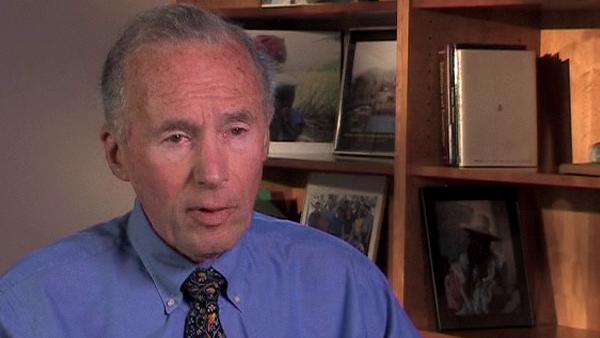NEXT STORY

Rallying support for the eradication of multidrug-resistant TB
RELATED STORIES

NEXT STORY

Rallying support for the eradication of multidrug-resistant TB
RELATED STORIES



I became really quite actively involved with them in the middle of the 90s when they, after they had discovered an epidemic of multidrug-resistant tuberculosis [MDR-TB] in Peru in a barrio in Lima where they had been delivering medical care. That problem of MDR-TB was one that was, of course, lethal and they began treating patients with second-line drugs, as many as four or five or six a day. Now, their approach as anthropologists in the communities in which they worked then and where they've worked since, has been first to get to know the community, to train community health workers as medical assistants, and thus, when a patient is found to have MDR-TB and let's... is put on, let's say, five drugs a day, that patient isn't given the prescription or even the drugs, rather the individual, the neighbor in the next barrio who's been trained as a community health worker comes to see the patient three times a day, delivers the medication, watches the patient take the medication and reports any side effects to a nurse or to a doctor.
Resistance is great problem with respect to all micro-organisms, and one of the principle causes of resistance, of course, is when an individual takes a drug, but not long enough to wipe out the infection, thus the bug in question, the microbe in question, has had a chance to condition itself to the antibiotic and thus to... to be able to live with it. Resistance is a not a phenomenon that is seen in the places where Paul and Jim work. They showed me their results in... in Peru and they reached 100 patients and it was clear that 85 had been cured. They asked my help in approaching the World Health Organization that had really decreed that it wasn't cost-effective to treat people with MDR-TB. Paul and Jim are able to do cost-effectiveness analysis, but they don't... they feel it doesn't apply when a human life is concerned, and particularly the life of an impoverished person, so they persisted.
Born in 1925, American Howard Hiatt set up one of the first medical oncology research and training units in the US and has headed up some of America's most prestigious medical institutions. Hiatt attended Harvard College and received his MD from the Harvard Medical School in 1948. He was a member of the team at the Pasteur Institute, Paris, that first identified and described mRNA, and he was among the first to demonstrate mRNA in mammalian cells. From 1991 to 1997, he was Secretary of the American Academy of Arts and Sciences, where he began and directs the Academy's Initiatives For Children program. He is also committed to helping disadvantaged people access decent health care.
Title: Tackling multidrug-resistant TB in Peru
Listeners: Milton C. Weinstein
Milton C. Weinstein, Ph.D., is the Henry J. Kaiser Professor of Health Policy and Management at the Harvard School of Public Health and Professor of Medicine at the Harvard Medical School. At the Harvard School of Public Health he is Academic Director of the Program in Health Decision Science, and Director of the Program on Economic Evaluation of Medical Technology . He is best known for his research on cost-effectiveness of medical practices and for developing methods of economic evaluation and decision analysis in health care. He is a co-developer of the CEPAC (Cost-Effectiveness of Preventing AIDS Complications) computer simulation model, and has conducted studies on prevention and treatment of HIV infections. He is the co-developer of the Coronary Heart Disease Policy Model, which has been used to evaluate the cost-effectiveness of cardiovascular prevention and treatment. He is an author of four books: Decision Making in Health and Medicine: Integrating Evidence and Values; Cost-Effectiveness in Health and Medicine,the report of the Panel of Cost Effectiveness in Health and Medicine; Clinical Decision Analysis; and Hypertension: A Policy Perspective.He has also published more than 200 papers in peer-reviewed medical, public health, and economics journals. He is an elected member of the Institute of Medicine of the National Academy of Sciences, and a recipient of the Award for Career Achievement from the Society for Medical Decision Making. Dr. Weinstein received his A.B. and A.M. in Applied Mathematics (1970), his M.P.P. (1972), and his Ph.D. in Public Policy (1973) from Harvard University.
Tags: Peru, Partners in Health
Duration: 3 minutes, 43 seconds
Date story recorded: September 2006
Date story went live: 24 January 2008